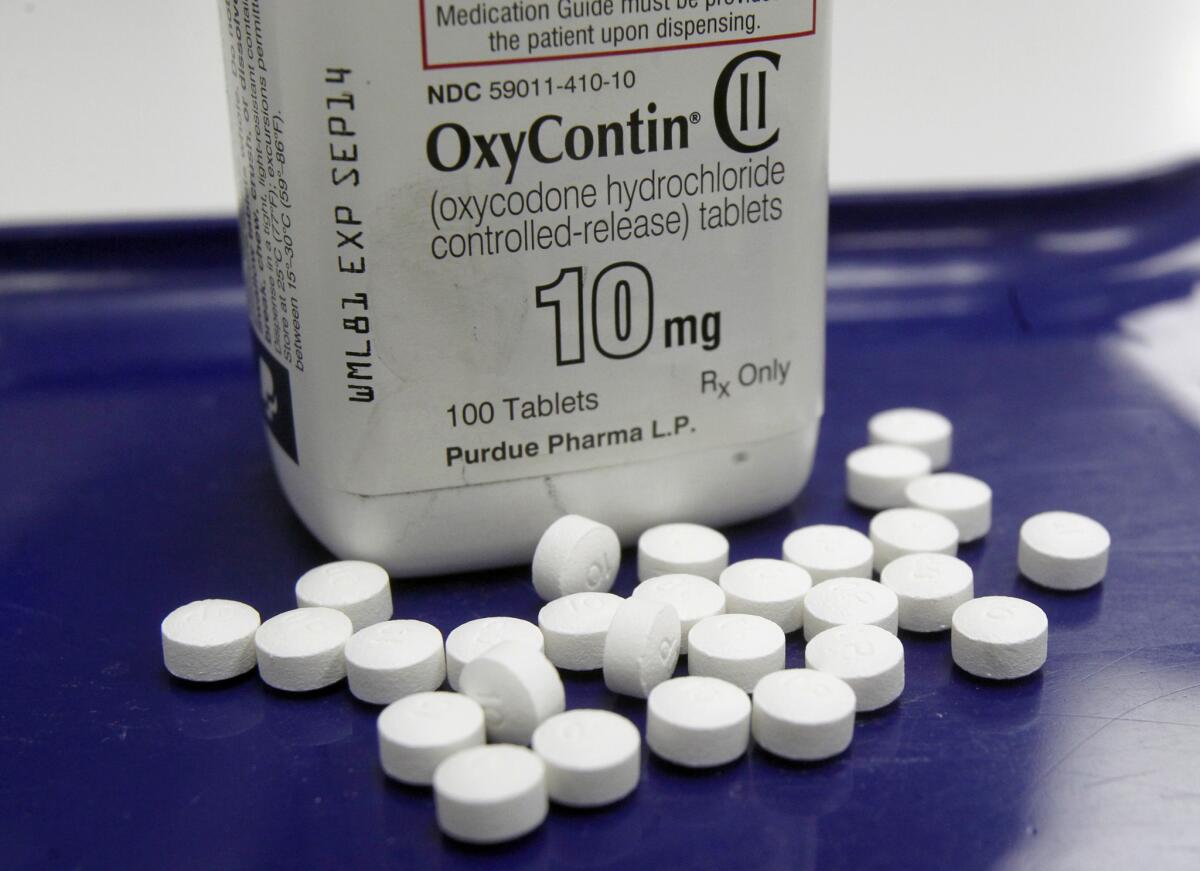Opioids are bad medicine for chronic pain, say new federal guidelines

OxyContin pills at a pharmacy in Montpelier, Vt.
- Share via
Federal health officials speaking in unusually blunt terms Tuesday called on the American medical community to turn away from treating common ailments with highly addictive painkillers, saying the nation’s prescription drug epidemic was a “doctor-driven” crisis.
The appeal accompanied the release of new guidelines by the Centers for Disease Control and Prevention that strongly discourage doctors from prescribing opiates — such as OxyContin, Percocet and Vicodin — for back problems, migraines, arthritis and other chronic conditions, a routine practice over the last decade and a half.
“For the vast majority of patients, the known serious and all-too-often-fatal risks far outweigh the unproven and transient benefits,” said Dr. Tom Frieden, CDC director. Nearly all the opiate painkillers physicians prescribe “are just as addictive as heroin,” he added.
Join the conversation on Facebook >>
The CDC guidelines are not binding on doctors, but Frieden said state agencies, private insurers and other groups might look to the recommendations in setting their own rules. The agency underscored its serious doubts about the effectiveness and safety of painkillers to physicians with articles Tuesday in the New England Journal of Medicine and the Journal of the American Medical Assn. outlining the new recommendations.
“We know of no other medication routinely used for a nonfatal condition that kills patients so frequently,” Frieden and a colleague wrote in the New England Journal of Medicine. Some experts predicted that even without new regulations, the CDC’s warning would have an immediate effect on how clinicians wield their prescription pads.
“Doctors hold the CDC in high regard, and its recommendations are going to be taken seriously,” said Dr. Andrew Kolodny, executive director of Physicians for Responsible Opioid Prescribing. “For the first time, the federal government is communicating clearly that the widespread practice of treating common conditions with long-term opioids is inappropriate.”
The guidelines are part of a federal response to the surging rates of opiate addiction in the U.S. Since 1999, more than 165,000 people in the U.S. have died of causes related to painkiller use. The CDC guidelines note that the deaths have paralleled an enormous increase in the sales of these drugs. About 250 million painkiller prescriptions were written in 2013, enough, the agency noted, “for every American adult to have a bottle of pills.”
In praising the new guidelines, Health and Human Services Secretary Sylvia M. Burwell said she had seen firsthand the devastation caused by painkiller abuse in her native West Virginia and called opiate deaths “one of the most pressing health issues.”
“Combating the opioid epidemic is a national priority,” Burwell said.
The guidelines issued Tuesday apply to chronic pain patients, those whose pain persists longer than three months, but not cancer patients or the terminally ill. In drawing up the guidelines, the CDC said it conducted an exhaustive review of the scientific literature and consulted with hundreds of leading experts, advocacy groups, government agencies and citizens. Scientists with “significant” ties to the pharmaceutical industry were not involved in drafting the guidelines, the agency said.
The analysis found clinical studies demonstrating that short-term use of painkillers could help patients, but there was “insufficient evidence to determine long-term benefits.” Some studies showed extended use of the drugs actually exacerbated patients’ pain. The analysis also found that up to 26% of chronic pain patients taking the drugs long-term became dependent on them. Patients were also at risk of overdose. In one 2015 study from Canada, 1 in 32 patients taking high-dose painkillers long-term died of an opioid-related cause.
The conclusion that the risks of opioids trump the benefits represents a complete turnabout from the 1990s. After OxyContin debuted in 1996, it became the go-to pain treatment for many primary-care doctors. When reports of painkiller abuse surfaced, many in the medical field blamed recreational abusers. In recent years, however, the focus has shifted to the role of doctors. A 2012 Los Angeles Times analysis of 3,733 fatalities found that drugs prescribed by physicians to patients caused or contributed to nearly half the deaths.
“The prescription overdose epidemic is doctor-driven,” Frieden said. “It can be reversed in part by doctors’ actions.”
The CDC recommends doctors choose treatments other than opioid painkillers, including less-potent medications such as acetaminophen and ibuprofen, exercise regimens, behavioral therapy and injections. If these painkillers are prescribed, doctors should use the lowest dose possible and monitor patients closely for signs of abuse. The guidelines also recommend that three days of opioid painkillers should be sufficient for short-term acute pain, such as recovery from surgery or trauma. Leftover pills in medicine cabinets have long been a source of abuse for teenagers and others.
Major insurers including Aetna and Cigna said Tuesday that they had just begun reviewing the guidelines and did not yet know if or how they would affect coverage. Officials from Medi-Cal, which provides health coverage to a third of Californians, said Tuesday that they planned to share the guidelines with their physicians who prescribe opioids for chronic pain.
The American Medical Assn., which represents 200,000 doctors nationwide, said that it was “largely supportive” of the guidelines but on alert for “possible unintended consequences.”
“We know this is a difficult issue and doesn’t have easy solutions and if these guidelines help reduce the deaths resulting from opioids, they will prove to be valuable,” said Dr. Patrice A. Harris, chair of the AMA Task Force to Reduce Opioid Abuse.
Dr. Lynn Webster, the former president of the American Academy of Pain Medicine and a consultant to drug companies developing pain drugs, said that opioid painkillers worked well for some patients.
“That doesn’t mean it’s optimal treatment, and there are many side effects,” he said. He said the CDC should acknowledge the problem with untreated pain as it tries to solve the opioid crisis, and he called on Congress to fund a “Manhattan Project” for better medications.
“We need drugs that aren’t addictive,” he said.
Some who lost loved ones to addiction applauded the CDC’s action. Margie Borth of Portland, Ore., said she blamed easy access to painkillers for the death of her son, Andrew, two years ago. The 24-year-old became addicted to OxyContin in college and then began using heroin.
“These drugs are just lying around in people’s medicine cabinets, and they’re prescribed like candy,” she said. “It stole my son away and killed him.”
Some chronic pain patients said they were dismayed by the guidelines. Sue Walker of Richmond, Va., who was diagnosed with fibromyalgia two decades ago, takes opioid pain medications daily and said she feared doctors would stop prescribing drugs to people who depend on them.
“I know people who have lost their access entirely,” Walker said.
soumya.karlamangla@latimes.com
MORE FROM SCIENCE
To quit smoking, it’s best to go cold turkey, study finds
Does shark skin really reduce drag? Not so fast, study says
‘Missing link’ helps explain how T. rex became king of the dinosaurs








